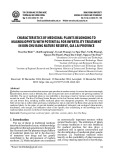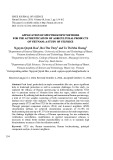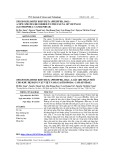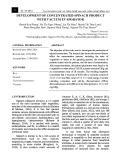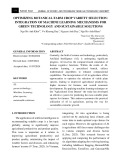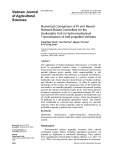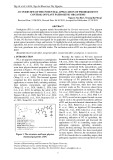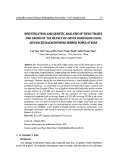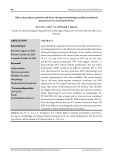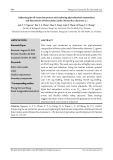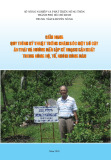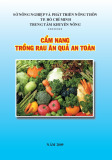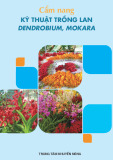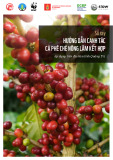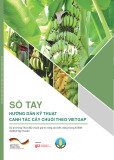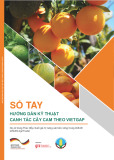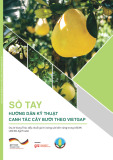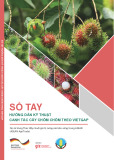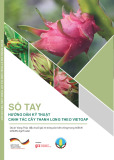
5
https://doi.org/10.52111/qnjs.2023.17101
Tạp chí Khoa học Trường Đại học Quy Nhơn, 2023, 17(1), 5-20
Thuốc trừ sâu: mục tiêu, cơ chế hoạt động
và đánh giá rủi ro
Yves Combarnous1, Nguyễn Thị Mộng Điệp2,*
1Đơn vị Sinh lý sinh sản và Hành vi (PRC), INRAe, CNRS, Trường Đại học Tours, 37380 Nouzilly, Pháp
2Khoa Khoa học Tự nhiên, Trường Đại học Quy Nhơn, Thành phố Quy Nhơn, tỉnh Bình Định, Việt Nam
Ngày nhận bài: 03/10/2022; Ngày nhận đăng: 31/01/2023; Ngày xuất bản: 28/02/2023
TÓM TẮT
Thuốctrừsâu(chủyếulàthuốcdiệtcỏ,diệtcôntrùng,sâuvàdiệtnấm)đượcsửdụngđểtiêudiệtmộtsố
loàithựcvật,độngvậthoặcvisinhvậtcóhạichonôngnghiệp.Donhữngđiểmtươngđồngcơbảntrongtấtcảcác
sinhvậtsống,việctấncôngmụctiêulàcácloàikhôngmongmuốnmàkhôngảnhhưởngđếnnhữngloàikhác,kể
cảconngườilàmộttháchthức.Theoquanđiểmnày,việcxácđịnhchínhxáccácphântửhoặccơchếtấncôngmục
tiêucủathuốctrừsâulàvôcùngquantrọngđểđánhgiárủirovàpháttriểncácchếphẩmthuốctrừsâuhiệuquả,
ítgâynguyhiểmđếncâytrồng,độngvậthoangdãvàconngười.Bàibáonàysẽtrìnhbàyngắngọnvềcácnhóm
thuốctrừsâuphổbiến,cơchếhoạtđộngcũngnhưđộctínhcủachúngđốivớimụctiêuvàtácdụngphụcóthểxảy
rađốivớicácthànhphầncủamôitrườngnhưquầnthểcôntrùngvàthựcvật,khôngkhí,nướchoặchệsinhvậtđất.
Từ khóa: Đa dạng sinh học, thuốc trừ sâu, thuốc diệt cỏ, thuốc diệt côn trùng, thuốc diệt nấm.
*Tác giả liên hệ chính.
Email: nguyenthimongdiep@qnu.edu.vn
TRƯỜNG ĐẠI HỌC QUY NHƠN
KHOA HỌC
TẠP CHÍ

6Quy Nhon University Journal of Science, 2023, 17(1), 5-20
https://doi.org/10.52111/qnjs.2023.17101
QUY NHON UNIVERSITY
SCIENCE
JOURNAL OF
Pesticides: targets, mechanisms
of action, and risk assessment
Yves Combarnous1, Thi Mong Diep Nguyen2,*
1INRAe, CNRS, Tours University, Unité de Physiologie de la Reproduction & des Comportements
(PRC) 37380 Nouzilly, France
2Faculty of Natural Sciences, Quy Nhon University, Quy Nhon city, Binh Dinh Province, Vietnam
Received: 03/10/2022; Accepted: 31/01/2023; Published: 28/02/2023
ABSTRACT
Pesticides (mainly herbicides, insecticides, and fungicides) are used to chemically combat certain plants,
animals, or microorganisms perceived as harmful to agriculture. Due to the fundamental similarities in all living
beings, it is challenging to target unwanted species without affecting others, including humans. In this perspective,
precisely identify the molecules or mechanisms targeted by pesticides is of utmost importance for assessing risk
anddevelopingefficientpesticidepreparationswithlimiteddamagetocrops,wildlifeandhumans.Thisreview
willbrieflypresentthegroupofcommonpesticides,theirmechanismsofactionaswellastheirtoxiceffectson
the target and possible side effects on the components of the environment such as insects and plants populations,
air, water, or soil biota.
Keyword: Biodiversity, pesticides, herbicides, insecticides, fungicides.
*Corresponding author.
Email: nguyenthimongdiep@qnu.edu.vn
1. INTRODUCTION
Originally, the term pest was limited to
“Insects or small animals which damage crops
or food supplies”.1 With this first definition,
only insecticides (meaning insect killer) and
rodenticides (rodent killer in general) would be
called pesticides. The definition has now been
extended to “Something resembling the pest
(plague) in destructiveness especially, a plant
or animal detrimental to humans or human
concerns, such as agriculture or livestock
production”.2 With this definition, herbicides
are included among pesticides, representing
about80%oftheirtotaluse. Moreover, in the
scientific literature, fungicides (fungi killers)
and bactericides (bacteria killers) are now taken
into consideration under the general term of
“pesticide” as well as many specialized products
such as molluscicides (snails and slugs killers),
nematicides (nematodes killer), etc.
The pesticides are intended to protect
crops by acting against deleterious weeds,
insects (and other invertebrates), fungi,
or microorganisms. It is obvious that the
mechanisms of action against such a variety
of targets should be different to retain the
highest possible specificity to destroy the
undesired species without negatively affecting
the crop to be protected as well as humans and
wildlife.3Aboutathousandchemicalpesticides

Quy Nhon University Journal of Science, 2023, 17(1), 5-20 7
https://doi.org/10.52111/qnjs.2023.17101
QUY NHON UNIVERSITY
SCIENCE
JOURNAL OF
employing more than a hundred unique
mechanisms have been developed. One of the
challenge is to have available strains resistant
to the pesticides used against the organisms
harmful to the crops.3 Thus, it is of utmost
importance to have good knowledge of the
pesticides targets and mechanisms of action
to protect crops without affecting wildlife and
human health.
2. PESTICIDE FAMILIES (STRUCTURES
AND TARGETS)
Numerous pesticides with various structures
have been developed to combat different pests
affectingcrops(Table 1 and figure1).Interm
of total quantity, around 55% are herbicides,
6%insecticidesand29%fungicidesinorderto
control~1800weeds,~10000insectpests,and
~80000fungi.
Table 1. Overview of the main classes of pesticides.
Chemical Class Herbicides Insecticides Fungicides
Organochlorines2,4-Dichlorophenoxyaceticacid
(2,4-D)
dichlorodiphenyltrichloroethane
(DDT)
Endosulfan Hexachlorobenzene
Organophosphates Glyphosate Diazinon, Omethoate,
Dimethoate,
Chlorpyrifos, Maldison,
Methidathion
Carbamates and
thiocarbamides
Aldicarb,Carbofuran,
Oxamyl,
Carbaryl, Methomyl,
Pirimicarb, Thiodicarb
Metal-organic
dithiocarbamates
Nabam(algicide) Maneb, Mancozeb,
Zineb
Urea derivatives Diuron,Fenuron,Metoxuron,
Miuron,Linuron,Monuron
Heterocyclic
compounds
Brassinazole Triazines
Atrazine
Strobilurins,
Benzimidazole,
Triazole derivatives
Phenol and
nitrophenol
derivatives
Dinocap Dinoseb Dinoseb
Fluorine-containing
compounds
Phenylpyrazoles,
Acetopyrazole
Fipronil Dichlofluanid
Copper-containing
compounds
Cuprousoxide,
Copper sulfate,
Copper octanoate.
Copperhydroxide,
Copperoxychloride
sulfate

8Quy Nhon University Journal of Science, 2023, 17(1), 5-20
https://doi.org/10.52111/qnjs.2023.17101
QUY NHON UNIVERSITY
SCIENCE
JOURNAL OF
Synthetic
pyrethroids
Allethrin,
Alpha-cypermethrin,
Beta-cyfluthrin,
Bifenthrin
Cypermethrin,
Cyfluthrin,
Deltamethrin,
Esfenvalerate,
Fluvalinate,
Fenvalerate,
Lambda-cyhalothrin,
Pyrethrins
Neonicotinoids Acetamiprid,
Clothianidin,
Imidacloprid,
Thiamethoxam
Others Spiroxamine
Figure 1. Chemical structure of a few pesticides.
4
hotosystem II (PSII) inhibitors
- -
hydroxybenzonitrile(e.g.bromoxynil)
Superoxide
S
chloroacetamides (e.g. acetochlor, S-
Auxin pathway disruptors such as
phenoxy and benzoic acids (e.g. 2,4- -
phenoxyaceticacid -
-hydroxyphenylpyruvate dioxygenase
All
enzyme (AChE),
The toxicity of
lesstoxiccarbamates(
λ-
Neonicotinoids
-
-
AChreceptor(nAChR)

Quy Nhon University Journal of Science, 2023, 17(1), 5-20 9
https://doi.org/10.52111/qnjs.2023.17101
QUY NHON UNIVERSITY
SCIENCE
JOURNAL OF
2.1. Herbicides
Prominent herbicides belong to seven
main families:
1) Photosystem II (PSII) inhibitors
showing various cross-resistances among
sub-families a) triazines (e.g. atrazine),
pyridazinone (e.g. pyrazon), phenylcarbamate,
b) anilide (e.g. propanil), ureas (e.g. diuron),
c) benzothiadiazinone (e.g. bentazone),
hydroxybenzonitrile(e.g.bromoxynil).
2) Superoxide promoters in chloroplasts
such as paraquat and diquat.
3)Shikimimateinhibitorssuchasglycine
derivatives (e.g. glyphosate).
4) Tubulin polymerization inhibitors such
as dinitroanilines (e.g. pendimethalin).
5) Gibberillin pathway inhibitors
such as chloroacetamides (e.g. acetochlor,
S-metolachlor).
6) Auxin pathway disruptors such as
phenoxy and benzoic acids (e.g. 2,4-dichloro-
phenoxyaceticacid2,4-D).
7)4-hydroxyphenylpyruvatedioxygenase
(HPPD) inhibitors (e.g. mesotrione).
2.2. Insecticides
Prominent chemical insecticides include
organochlorines, organophosphates, carbamates,
pyrethroids, and neonicoticoids.
1) Organophosphates (e.g. chlorpyriphos,
acephate, dimethoate) and carbamates largely
replaced organochlorines such as DDT.
All operate through the inhibition of the
acetylcholinesterase enzyme (AChE), causing
acetylcholine to transfer nerve impulses
endlessly, and then inducing weakness or
paralysis.Thetoxicity of Organophosphatesto
vertebrates led to their partial replacement by the
lesstoxiccarbamates(e.g.carbofuran).
2) Pyrethroid insecticides (e.g.
λ-cyhalothrin) are the synthetic counterparts
of the pyrethrin pesticide, naturally found in
chrysanthemums.
3)Neonicotinoids(e.g.imidacloprid)are
insecticidesoftheneuro-activeclassstructurally
similar to nicotine5-6andtargetthenicotinicACh
receptor(nAChR).
2.3. Fungicides
Contact fungicides work by preventing fungal
spores from germinating or penetrating into
the plant from the leaf surface. They require
care in the application as complete coverage is
essential for effectiveness.
Penetrant fungicides work inside the
plant and can be locally systemic or translocated
throughout the plant. They can be preventative
and curative.
The most common fungicides are:
1) Respiration inhibitors like succinate
dehydrogenase inhibitors (SDHIs) or quinone
outside inhibitors (QoIs).
2) Sterol biosynthesis inhibitors such as
demethylation inhibitors DMIs which disrupt
the fungi cell membrane and organelles after
spore germination.
3) Fungicides are also necessary to
combat fungi affecting animals, particularly
humans (Candida albicans and others). These
products for humans are pharmaceutical drugs
and not « pesticides » as they are not dispersed in
theenvironmenttoprotectcrops.Nevertheless,
themselves or their metabolites can be found in
theenvironmentandexerttoxiceffects.
3. PESTICIDE CHEMICAL STRUCTURES
AND MECHANISMS OF ACTION
Depending on their structure (Figure 1), the most
commonly used pesticides can be divided into
different chemical groups7 with various usages
(Table 1). The different biological targets are,
of course, determined by the chemical structure
of their targets. It is expected that chemical
specificity would lead to biological specificity.
Nevertheless, many of them exert non-specific
oxidative stress.8 A number of pesticides now
consistofmicroorganismsortoxinsfromthem,
instead of chemicals.9-10

